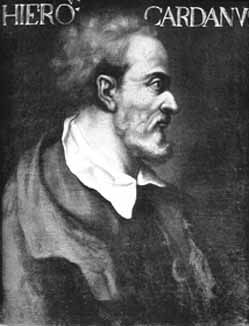- About MAA
- Membership
- MAA Publications
- Periodicals
- Blogs
- MAA Book Series
- MAA Press (an imprint of the AMS)
- MAA Notes
- MAA Reviews
- Mathematical Communication
- Information for Libraries
- Author Resources
- Advertise with MAA
- Meetings
- Competitions
- Programs
- Communities
- MAA Sections
- SIGMAA
- MAA Connect
- Students
- MAA Awards
- Awards Booklets
- Writing Awards
- Teaching Awards
- Service Awards
- Research Awards
- Lecture Awards
- Putnam Competition Individual and Team Winners
- D. E. Shaw Group AMC 8 Awards & Certificates
- Maryam Mirzakhani AMC 10 A Awards & Certificates
- Two Sigma AMC 10 B Awards & Certificates
- Jane Street AMC 12 A Awards & Certificates
- Akamai AMC 12 B Awards & Certificates
- High School Teachers
- News
You are here
Solving the Cubic with Cardano - Introduction
Introduction
I will present Cardano's solution to the cubic.
And I can already hear the response: "What? Why? Isn't his solution well understood? Why yet another article?"
True, the mathematical content of the solution is well-understood. However, the expression of that solution is not. Girolamo Cardano (1501-1576) worked before symbolism, before even the invention of the equals sign, so any symbolic presentation of his solution misses important aspects of his thought [Note 1]. I want to think along with Cardano, to understand his solution as he did, and to bring my students to an understanding of Cardano’s world of mathematics—his ways of thinking and the mathematical tools at his disposal. The elucidation of these points is my goal in this article.
 |
|
Girolamo Cardano (1501-1576) (Source: Convergence Portrait Gallery) |
Cardano, working at the very dawn of modern mathematics, drew on two mathematical traditions. The first, a geometric tradition, started in the hundred years before Cardano’s birth, with the collection and translation of many classical Greek mathematical texts, mostly by humanists who were strong on linguistics but weak on mathematics. During Cardano’s youth better translations, made by those skilled in both mathematics and Greek, came to market. These translators derived proofs for those geometric theorems whose demonstrations had dropped out of the textual tradition and added new proofs for theorems whose ancient proofs were found deficient or too obscure. And so mathematical research developed, in part, out of the desire of these mathematically skilled translators to provide the genuine content of the ancient Greek texts, even if that required replacing the proofs in the (possibly corrupt) text at hand with new ones. Cardano wrote his Ars Magna (1545) [Note 2], including his solutions to the cubic, in this charged atmosphere of the renewal of classical Greek mathematics [Note 3].
The second mathematical tradition upon which Cardano drew was the everyday world of abbaco mathematics, taught in Italian dialects to children destined to be merchants and artisans. This was the mathematics of commerce: proportions, practical geometry and algebra up to quadratic equations, stemming ultimately from the mathematics of Islamic writers like al-Khwarizmi. Cardano had a foot in both traditions, having learned abbaco mathematics and a little Euclid from his father [Cardano 2002, p. 126], and more Euclid as a requirement for his medical degree. He drew heavily on both traditions in his Ars Magna, as the subject matter was algebra and the solution of equations, while the method of proof was geometric. I argue that Cardano’s methods of discovery and indeed his way of thinking about mathematics consisted of a blend of these two traditions.
To explain the uses Cardano made of geometry and abbaco mathematics, I will examine the solution that Cardano provided to the cubic problem \(x^3=ax^2+b.\) This exploration will uncover unfamiliar proofs, such as Cardano’s geometric depression of the cubic from \(x^3=ax^2+b\) to \(y^3=Ay+B,\) and traces of geometric and abbaco methods of discovery. Most importantly, it will both present how Cardano worked out one of the highest achievements of pre-symbolic algebra, and bring to light part of the lost world of the abbaco master.
In working through Cardano’s mathematics, I have used pictures of cubes made from manipulatives available here at St. Cloud State University (in St. Cloud, Minnesota). In teaching this subject, students have found that physically constructing Cardano’s three-dimensional arguments make them much easier to grasp. This also brings home the achievement of those mathematicians after Cardano, such as Descartes, who transformed questions about cubics from solid geometry to planar curves.
Notes for Introduction
- There are many such presentations, among which William Dunham's, in Chapter 6 of Journey through Genius, stands out. Dunham, however, translated Cardano's demonstration into modern algebraic symbolism, and noted that "The modern reader will notice that this equation can be derived instantly by simple algebra, without recourse to the arcane geometry of cubes and slats" [p. 144]. And this is the point of the present article: to see how Cardano thought, we have to examine Cardano's recourse to cubes and slats.
- Cardano started the Ars Magna in 1540, and it was published in 1545 by Johannes Petreius of Nuremburg.
- See Paul Lawrence Rose, The Italian Renaissance of Mathematics, for more details.
William B. Branson (St. Cloud State University), "Solving the Cubic with Cardano - Introduction," Convergence (October 2013), DOI:10.4169/convergence20131001




